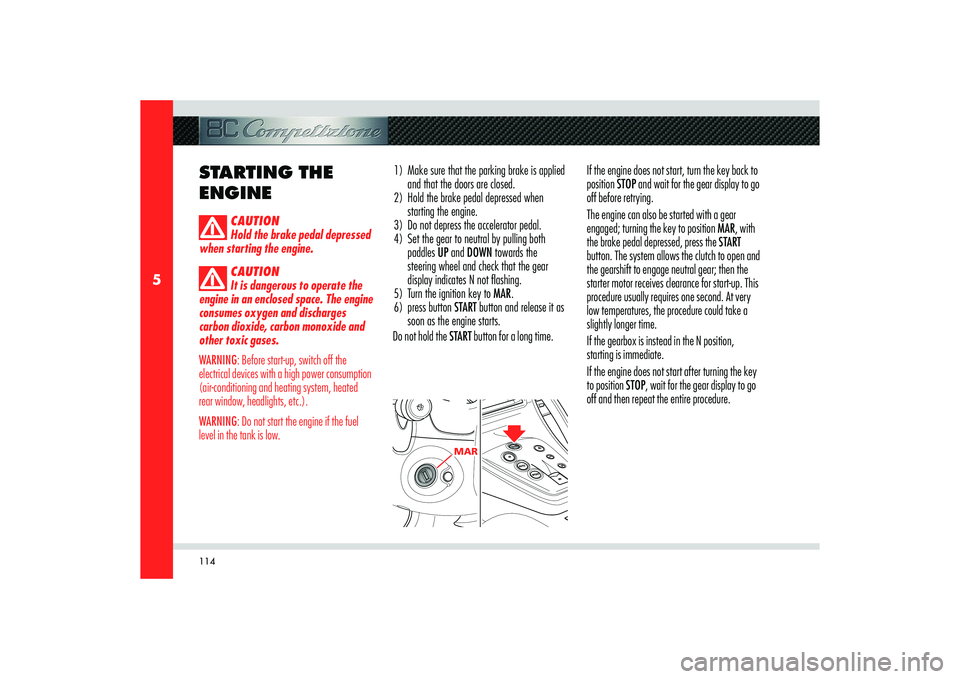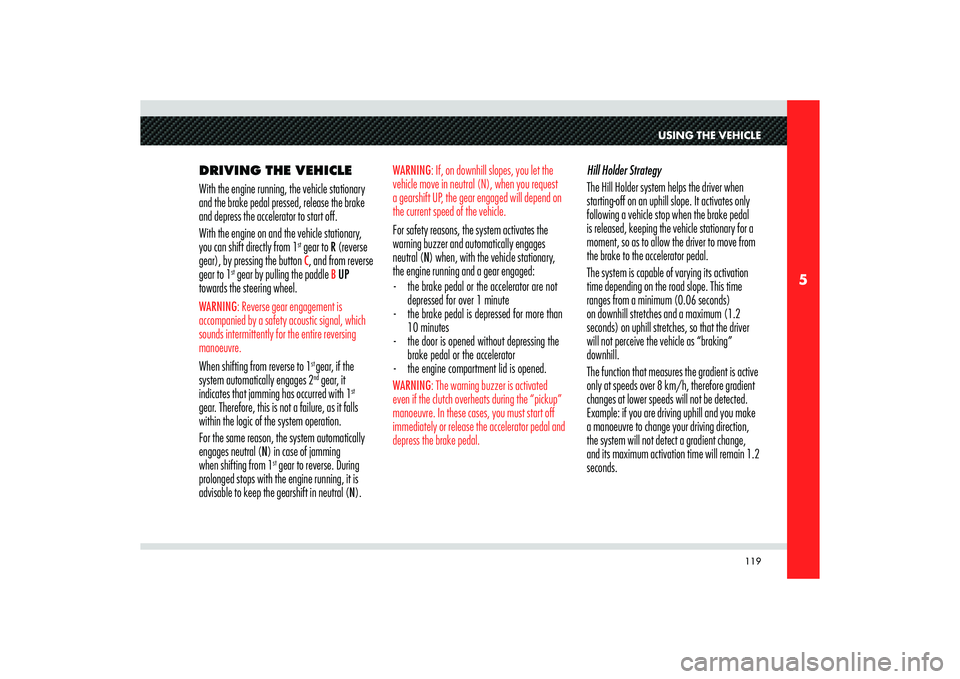clutch Alfa Romeo 8C 2009 Owner handbook (in English)
[x] Cancel search | Manufacturer: ALFA ROMEO, Model Year: 2009, Model line: 8C, Model: Alfa Romeo 8C 2009Pages: 223, PDF Size: 14.35 MB
Page 7 of 223

00 800 2532 8200Alfa8Care
INTRODUCTION
5
SERVICE
The information contained in this manual is
limited to those instructions and indications
that are strictly required for the use and good
preservation of the vehicle.
The Owner will certainly obtain greater
satisfaction and the best results from the vehicle
by following these instructions carefully.
We also advise you to have all the maintenance
services and inspections carried out by
the Authorised Service Centres of the
Manufacturer’s Network, where you will fi nd
specialised staff and suitable equipment.
Contact the dedicated Alfa8Care Customer
Number for the location of the Authorised
Service Centres of the Manufacturer’s
Network.“Q-SELECT”
The vehicle may come equipped with a
mechanical gearbox system with dry double-
plate clutch, controlled by an electro-hydraulic
system by means of the paddles on the steering
wheel.
Although the system can be used in “automatic”
mode, “Q-select” should not be considered as an
automatic gearbox. Therefore, for correct use,
carefully follow the instructions in the relative
section of this manual.AUDIO AND IT SYSTEMS
The vehicle is equipped with the following
systems:
- Becker car stereo and CD player with
Bluetooth voice controls and MP3 reader.
- Bose HI-FI system with 8 high-performance
speakers (optional).
- iPod connection (optional).
- 3D pictogram navigation system with route
display (optional).
TOWING THE VEHICLE
The vehicle has not been designed, developed
and homologated to be used as a towing vehicle
for other means (e.g. trailers, caravans, etc.)
and nothing can be loaded on the roof; fi tting
structures such as bars or roof-racks may damage
the vehicle.
Page 116 of 223

114
5
MAR
STARTING THE
ENGINE
CAUTION
Hold the brake pedal depressed
when starting the engine.
CAUTION
It is dangerous to operate the
engine in an enclosed space. The engine
consumes oxygen and discharges
carbon dioxide, carbon monoxide and
other toxic gases.
WARNING: Before start-up, switch off the
electrical devices with a high power consumption
(air-conditioning and heating system, heated
rear window, headlights, etc.).
WARNING: Do not start the engine if the fuel
level in the tank is low.
1) Make sure that the parking brake is applied
and that the doors are closed.
2) Hold the brake pedal depressed when
starting the engine.
3) Do not depress the accelerator pedal.
4) Set the gear to neutral by pulling both
paddles UP and DOWN towards the
steering wheel and check that the gear
display indicates N not fl ashing.
5) Turn the ignition key to MAR.
6) press button START button and release it as
soon as the engine starts.
Do not hold the START button for a long time.If the engine does not start, turn the key back to
position STOP and wait for the gear display to go
off before retrying.
The engine can also be started with a gear
engaged; turning the key to position MAR, with
the brake pedal depressed, press the START
button. The system allows the clutch to open and
the gearshift to engage neutral gear; then the
starter motor receives clearance for start-up. This
procedure usually requires one second. At very
low temperatures, the procedure could take a
slightly longer time.
If the gearbox is instead in the N position,
starting is immediate.
If the engine does not start after turning the key
to position STOP, wait for the gear display to go
off and then repeat the entire procedure.
Page 121 of 223

119
5
USING THE VEHICLE
DRIVING THE VEHICLE
With the engine running, the vehicle stationary
and the brake pedal pressed, release the brake
and depress the accelerator to start off.
With the engine on and the vehicle stationary,
you can shift directly from 1
st gear to R (reverse
gear), by pressing the button C, and from reverse
gear to 1
st gear by pulling the paddle
B UP
towards the steering wheel.
WARNING: Reverse gear engagement is
accompanied by a safety acoustic signal, which
sounds intermittently for the entire reversing
manoeuvre. When shifting from reverse to 1
st gear, if the
system automatically engages 2nd gear, it
indicates that jamming has occurred with 1
st
gear. Therefore, this is not a failure, as it falls
within the logic of the system operation.
For the same reason, the system automatically
engages neutral (N) in case of jamming
when shifting from 1
st gear to reverse. During
prolonged stops with the engine running, it is
advisable to keep the gearshift in neutral (N).Hill Holder Strategy
The Hill Holder system helps the driver when
starting-off on an uphill slope. It activates only
following a vehicle stop when the brake pedal
is released, keeping the vehicle stationary for a
moment, so as to allow the driver to move from
the brake to the accelerator pedal.
The system is capable of varying its activation
time depending on the road slope. This time
ranges from a minimum (0.06 seconds)
on downhill stretches and a maximum (1.2
seconds) on uphill stretches, so that the driver
will not perceive the vehicle as “braking”
downhill.
The function that measures the gradient is active
only at speeds over 8 km/h, therefore gradient
changes at lower speeds will not be detected.
Example: if you are driving uphill and you make
a manoeuvre to change your driving direction,
the system will not detect a gradient change,
and its maximum activation time will remain 1.2
seconds.
WARNING: If, on downhill slopes, you let the
vehicle move in neutral (N), when you request
a gearshift UP, the gear engaged will depend on
the current speed of the vehicle. For safety reasons, the system activates the
warning buzzer and automatically engages
neutral (N) when, with the vehicle stationary,
the engine running and a gear engaged:
- the brake pedal or the accelerator are not
depressed for over 1 minute
- the brake pedal is depressed for more than
10 minutes
- the door is opened without depressing the
brake pedal or the accelerator
- the engine compartment lid is opened.WARNING: The warning buzzer is activated
even if the clutch overheats during the “pickup”
manoeuvre. In these cases, you must start off
immediately or release the accelerator pedal and
depress the brake pedal.
Page 125 of 223

123
5
F
USING THE VEHICLE
“SPORT” mode
It is activated by pressing button
F; the letter “S”
will illuminate on the display.
To return to “NORMAL” mode from “SPORT”
mode, press the button again.
As “SPORT” mode has lower priority over “low-
grip” and “automatic gearshift” modes, if these
are already active when you activate “SPORT”
mode, the system will ignore the command even
though the relative warning light switches on.
CAUTION
“SPORT” mode is characterised
by faster gearshifts than in
“NORMAL” mode and engine power
reduction through the ASR system is
kept to a minimum.
Fast gearshifting however always depends on
the accelerator pedal travel and on the engine
RPM, as in “NORMAL” mode.
DOWNshifts with the accelerator pedal released,
will have a braking effect approaching the
skidding of the driving wheels on dry asphalt.
Under racing-style driving conditions with
gearshifts at high engine RPM, double-clutching
when up-shifting is performed automatically.
CAUTION
It is advisable not to use
“SPORT” mode on roads with low or
medium “grip” conditions (e.g. ice,
snow, or wet roads) as the driving
wheels could skid during gearshifts.
Therefore, excessive use of the vehicle
in “SPORT” mode is advisable only on
racetracks.
If you use a racing-style driving when starting-off
or gearshifting with SPORT mode active, you
might feel the driving wheels begin to slip even
on dry roads.
It is a good rule to deactivate the other operating
modes (“low-grip” and “automatic gearshift”)
before you select “SPORT” mode.
Page 183 of 223

181
7
CAPACITIES AND TECHNICAL SPECIFICATIONS
LUBRICATION SYSTEM
The lubrication system uses a wet sump system
and oil pump with the relative suction screen,
incorporated in the crankcase.TRANSMISSION
Clutch
Dry double-plate clutch with servo-assisted
hydraulic control. COOLING SYSTEM
Engine cooling is obtained by means of an anti-
freeze mixture circulating inside a system with
radiator, centrifugal pump and expansion tank.
Page 212 of 223

210
8
Precautions and warnings
- Make sure that the cables are not crushed
or come into contact with hot surfaces or
sharp edges.
- Do not cover the battery conditioner.
- Make sure that the mains connector is not
exposed to water.
- Never recharge a frozen battery.
- Never recharge a damaged battery.
- The connection to the mains must be
in compliance with domestic legislation
regarding high voltage.
- Always check the cables of the battery
conditioner before use: check that the
cables and external sheath are not cracked.
- Never use the battery conditioner if its
cables are damaged.
- Store and use the battery conditioner away
from children; do not allow children to play
with the device.Overheating protection
The battery conditioner is protected against
overheating.
If the ambient temperature rises, the output
power is reduced.
Maintenance
The battery conditioner does not require
maintenance.
The battery conditioner may not be
disassembled.
The casing of the device can be cleaned with a
soft and moist cloth or with neutral detergent.
Always disconnect the battery conditioner before
cleaning it.RESTARTING THE
VEHICLE
Before restarting the vehicle after a long period
of inactivity, we recommend that you perform
the following operations:
CAUTION
Check the tyres for pressure
and for any damages, cuts or cracks. If
this is the case, have them replaced.
- Do not dry-dust the exterior of the vehicle.
- Visually inspect if there are any fl uid leaks
(oil, brake and clutch fl uid, engine coolant
etc.).
- Have the engine oil and fi lter replaced.
- Check the fl uid levels in the braking system,
as well as the engine coolant level.
- Check the air fi lter and replace it if
necessary.
- Check the conditions of the engine belts.